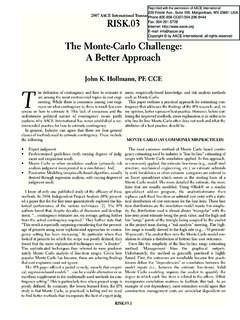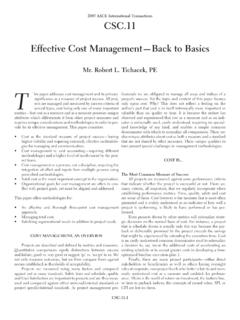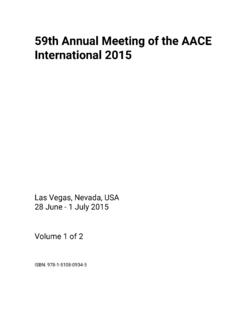Transcription of Alternate Methods for Integrated Cost & Schedule ...
1 2010 aace international transactions Alternate Methods for Integrated cost & Schedule contingency estimating John K. Hollmann, PE CCE CEP ABSTRACT Schedule contingency estimating is not widely used in project planning. Even less commonly used are Methods that integrate cost and Schedule contingency estimating . Only one Integrated method is well covered in the literature; , range simulation applied to a cost -loaded CPM Schedule . However, this method, as typically practiced, is poorly aligned with some of aace international s established principles for good contingency estimating practice. This paper presents the most commonly used Critical Path Method (CPM) model-based Methods , as well as an Alternate hybrid parametric model/expected-value method that does not rely on the CPM model and is designed to better align with principles of good contingency estimating practice while being practical to use on all projects.
2 Pros and cons of the Alternate Methods are discussed. The paper also explains why cost and Schedule risk analysis must be done at the same time regardless of the contingency estimating method used. 2010 aace international transactions Table of Contents Abstract .. 1 Table of Contents .. 2 List of Tables .. 2 3 Assumptions Regarding This Paper s Scope .. 3 CPM-Based Activity Ranging With cost Loading Method .. 4 Parametric/Expected-Value Hybrid Method .. 5 Method Comparison .. 6 Based on Principles of Practice ..6 Based on Strengths/Weaknesses ..8 Comparison Summary ..8 Why cost and Schedule Risk Analysis Must Be Performed Together ..9 Conclusions ..10 References .. 10 List of Tables Table 1 Integrated C/S contingency Methods vs. General Principles .. 7 Table 2 Integrated C/S contingency Methods Strengths vs. Weaknesses.
3 8 2010 aace international transactions Introduction/Background Having consulted on capital project benchmarking and practice improvement for many years, I have had the opportunity to observe the cost and Schedule risk analysis and contingency estimating practices used, and results obtained, by many global owner companies in the process related industries. On the positive side, recognition of the need for better risk management processes and Methods is growing. However, the following are some cost / Schedule risk analysis problems or gaps observed: Few are doing Schedule risk analysis or contingency estimating (further, many firms lack any significant in-house planning and scheduling competency). cost and Schedule risk analysis and contingency estimating are rarely Integrated .
4 There is little awareness of aace Recommended Practices or the landmark industry research behind them. Project cost and Schedule predictability seem to be getting worse (while the stakes are becoming greater all the time). Some of these gaps result from basic lacking in capital management leadership and/or cost engineering competency (particularly scheduling) in the owner companies. However, some of the gaps result from the industry as a whole having few effective, broadly applicable and practical tools for Integrated cost / Schedule contingency estimating to chose from. As aace international develops its Decision and Risk Management Professional (DRMP) specialty certification, these and other gaps in the literature and technology have become apparent to aace international . The aace international Technical committees are working to close these gaps by defining recommended practices.
5 In that light, I hope that this paper will serve as a potential catalyst for a new aace international Recommended Practice (RP). The paper reviews the most common Integrated cost / Schedule contingency estimating method (CPM-based activity ranging with cost loading), presents an alternative new practice (parametric/expected-value hybrid), and compares them. These two Methods are then compared against aace international s first principles yardstick for evaluating contingency estimating practices [1]. Assumptions Regarding This Paper s Scope This paper is intended for those considering which Integrated cost / Schedule contingency estimating method to use on their projects. The paper further assumes that these readers already have an intermediate level of knowledge of risk management processes, Monte-Carlo modeling, parametric estimating , and estimating contingency based on probabilistic estimating outputs ( , the types of things covered by aace international Recommended Practices).
6 The scope of the Methods described in the paper assumes that contingency estimating will be applied in a risk management process. For example, such a process is described in aace international s Total cost Management (TCM) Framework Section [2]. In the TCM process, contingency estimating is a distinct step. Readers should note that the TCM process is the only industry risk management process model that highlights contingency estimating . Most, as exemplified in the ISO risk management 2010 aace international transactions process [3], do not effectively integrate risk quantification with project control planning. The TCM process, like all risk management processes, starts with identifying risks and assessing and screening them for the purpose of treating them ( , mitigate, transfer, etc).
7 This paper does not focus on these initial steps; it is focused on estimating contingency ( , time and costs allowances for uncertainty in project plans) for the residual risks that remain after risk treatment. It also does not focus on the risk workshop/analysis aspect of the contingency estimating process; workshop performance tends to be similar for all the Methods described here. In summary, the paper is focused solely on the contingency quantification step. CPM-Based Activity Ranging With cost Loading Method The purpose of the cost Loaded Critical Path Method (CPM) class of Methods is to leverage the ability of modern scheduling tools to support resource-loading and Monte-Carlo modeling. The CPM-based class of Methods (which are the most commonly used although still not widely) is better described in other papers and an aace RP in draft at time of writing.
8 [4,5,6]. However, in summary (and at the risk of over simplification), the cost Loaded CPM Methods have the following steps: 1. Develop the base ( contingency -free) project estimate and Schedule . Optimally, these are Integrated using a common work breakdown structure (WBS). The Schedule must be a high quality CPM Schedule model. 2. Resource load the Schedule with all cost information. The costs include the entire project budget, generally at a summary level (note that this is not resource-leveling; that cost / Schedule integration step should have been already done if it is a quality Schedule ). Resources that are time-dependent ( , labor or equipment with a daily rate) are distinguished from those that are not ( , materials). 3. Assess and enter the risk information in the Schedule model (the Schedule tool must support Monte-Carlo modeling).
9 There are several Alternate Methods for doing this: a. Activity Ranging: Replace the cost -loaded activity duration with a probability distribution (typically triangular or 3-point; low, most-likely, high) based on project team assessment of the range (risks are not explicitly identified or linked to impacts in the model). Impacts on non-time dependent costs are considered through traditional cost ranging. b. Risk Driver: Starting with a list of residual risks (plus a general background risk), link the risk to activity-by-activity time multipliers (factors) and also cost factors for non-time dependent costs. Then, assess and input the probability of occurrence ( , 50%) of each risk, and assess and input ranges on the activity and cost multiplier factors (again, typically triangular or 3-point; , , , ). 4.
10 Run the Monte-Carlo model and determine the cost and Schedule contingency based on management s tolerance for risk and the model s probabilistic output. There are a number of potential variations from the typical approach described above. These options include (but are not limited to): Risk Driver (option 3b above): The use of this method is increasing since commercial tools to support it were introduced circa 2005. 2010 aace international transactions Conditional Branching: What if a risk event happens which would cause the team to change the Schedule logic? To address this common situation, conditional branching (conditioned by occurrence of the risk), could be incorporated in the Schedule model. However, the author has never seen or read of this being done in regular practice ( , static logic , unaffected by risk events, is almost always assumed).











